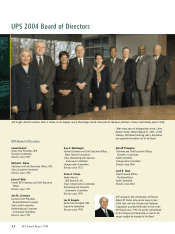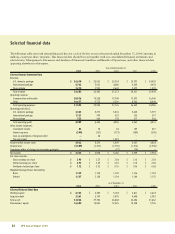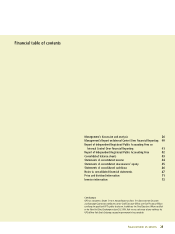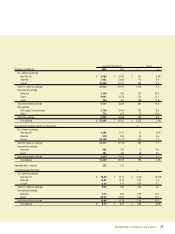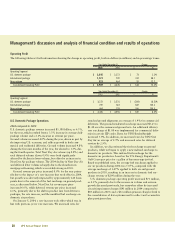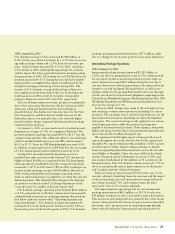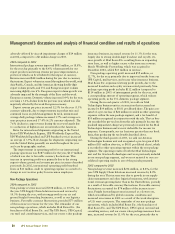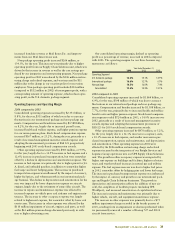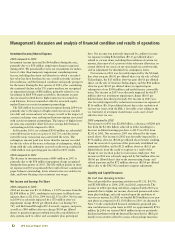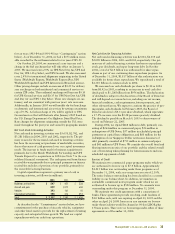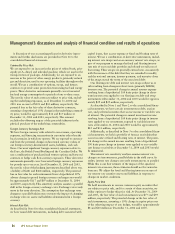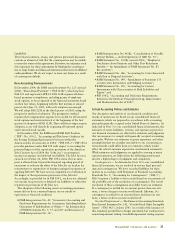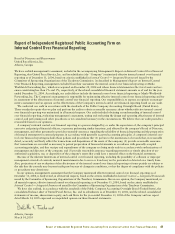UPS 2004 Annual Report Download - page 33
Download and view the complete annual report
Please find page 33 of the 2004 UPS annual report below. You can navigate through the pages in the report by either clicking on the pages listed below, or by using the keyword search tool below to find specific information within the annual report.
Management’s discussion and analysis 31
increased franchise revenue at Mail Boxes Etc. and improve-
ments from our Mail Innovations unit.
Non-package operating profit increased $266 million, or
134.3%, for the year. This increase was primarily due to higher
operating profit from our Supply Chain Solutions unit, which was
driven by the increase in revenue as well as the cost savings pro-
duced by our integration and restructuring program. Non-package
operating profit in 2002 was reduced by the $106 million restruc-
turing charge and related expenses, and was increased by $11
million due to the change in our vacation policy for non-union
employees. Non-package operating profit includes $114 million
(compared to $112 million in 2002) of intersegment profit, with a
corresponding amount of operating expense, which reduces oper-
ating profit, in the U.S. domestic package segment.
Operating Expenses and Operating Margin
2004 compared to 2003
Consolidated operating expenses increased by $2.553 billion, or
8.8%, for the year, $311 million of which was due to currency
fluctuations in our international package and non-package seg-
ments. Compensation and benefits increased by $1.588 billion,
or 8.2%, for the year, largely due to increased payroll costs,
increased health and welfare expense, and higher pension expense
for our union pension plans. Stock-based compensation expense
increased $167 million, or 23.2%, during the year, primarily as a
result of increased management incentive awards expense and
adopting the measurement provisions of FAS 123 prospectively
beginning with 2003 stock-based compensation awards.
Other operating expenses increased by $965 million, or 9.9%,
for the year, largely due to a 34.9% increase in fuel expense and a
12.6% increase in purchased transportation, but were somewhat
offset by a decline in depreciation and amortization expense. The
increase in fuel expense was primarily due to higher prices for Jet-
A, diesel, and unleaded gasoline, in addition to somewhat higher
fuel usage and lower hedging gains. The increase in purchased
transportation expense was influenced by the impact of currency,
higher fuel prices, and volume growth in our international pack-
age business. The decline in depreciation and amortization for the
year was impacted by lower depreciation expense on aircraft
engines, largely due to the retirement of some older aircraft. The
increase in repairs and maintenance expense was affected by
increased expense on vehicle parts and airframe and engine main-
tenance. The increase in other occupancy expense was largely
related to higher rent expense, but somewhat offset by lower real
estate taxes. The increase in other expenses was affected by the
$110 million impairment of aircraft, engines, and parts, as well
as the $63 million pension charge discussed previously, in addi-
tion to higher advertising costs.
Our consolidated operating margin, defined as operating
profit as a percentage of revenue, increased in 2004 compared
with 2003. The operating margins for our three business seg-
ments were as follows:
Year Ended December 31,
2004 2003 2002
Operating Segment
U.S. domestic package 12.6% 13.1% 14.9%
International package 16.6% 12.7% 6.9%
Non-package 16.3% 16.0% 7.4%
Consolidated 13.6% 13.3% 13.1%
2003 compared to 2002
Consolidated operating expenses increased by $1.864 billion, or
6.9%, for the year, $398 million of which was due to currency
fluctuations in our international package and non-package seg-
ments. Compensation and benefits increased by $1.388 billion, or
7.7%, for the year, primarily due to increased health and welfare
benefit costs and higher pension expense. Stock-based compensa-
tion expense totaled $724 million in 2003, a 14.0% increase over
2002, primarily as a result of increased management incentive
awards expense and adopting the measurement provisions of
FAS 123 for 2003 stock-based compensation awards.
Other operating expenses increased by $476 million, or 5.2%,
for the year, largely due to a 12.3% increase in occupancy costs,
a 10.3% increase in fuel expense, and smaller increases in pur-
chased transportation, repairs and maintenance, and depreciation
and amortization. Other operating expenses in 2002 were
affected by the $106 million restructuring charge and related
expenses incurred in the integration of our Freight Services and
Logistics Group operations into our UPS Supply Chain Solutions
unit. The growth in other occupancy expense was impacted by
higher rent expense on buildings and facilities, higher real estate
taxes, and weather-related increases in natural gas and utilities
expense. The fuel expense increase was due to higher fuel prices
in 2003, somewhat offset by hedging gains and lower fuel usage.
The increase in purchased transportation expense was influenced
by the impact of currency and growth in our international pack-
age and Supply Chain Solutions businesses. The growth in
depreciation and amortization reflects the addition of new air-
craft, the completion of facilities projects (including UPS
Worldport), and increased amortization of capitalized software.
The increase in repairs and maintenance was primarily due to
higher vehicle, aircraft, and equipment maintenance expense.
The increase in other expenses was primarily due to a $75
million impairment charge recorded in the fourth quarter of
2003, resulting from an impairment evaluation performed when
we permanently removed a number of Boeing 727 and DC-8
aircraft from service.



